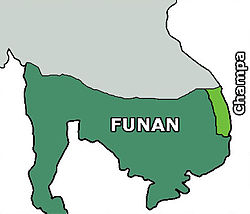Funan
Funan (Chinese: 扶南; pinyin: Fúnán; Khmer: ហ៊្វូណន, Hvunân [fuːnɑːn]; Vietnamese: Phù Nam, Chu Han: 夫南) was an ancient kingdom in Southeast Asia. This kingdom existed from the 1st to the 7th century CE.
Funan ហ៊្វូណន | |||||||
|---|---|---|---|---|---|---|---|
| 68–627 | |||||||
 | |||||||
| Capital | Vyādhapūra | ||||||
| Common languages | Proto-Malay (common), Sanskrit (religious) | ||||||
| Religion | Hinduism, Buddhism and Khmer Animism | ||||||
| Government | Monarchy | ||||||
| Historical era | Classical Antiquity | ||||||
• Established | 68 | ||||||
• Disestablished | 627 | ||||||
| Currency | Native coins | ||||||
| |||||||
| Today part of | |||||||
General
changeMost texts written about this subject was written by foreign travelers. As a result, information about this ancient kingdom is often disputed.[1]
Etymology
changeGeorge Cœdès[Author 1] thinks that the word Funan came from the word Bnaṃ or Vnaṃ in old Khmer. The modern Khmer word Phnom (meaning mountain or hill) came from this word.[2][3][4] Claude Jacques,[Author 2] however, disputes this theory. He pointed out that there is a wrong translation of the Sanskrit word Parvatabùpála as Bnaṃ.[5] There is no ancient Khmer text found using this word to refer to this kingdom.[6]
There are other explanations on how the word was formed. Claude Jacques believes the Chinese created this name because they likes to add 南 ("nan") to refer to regions "to the south" (Yunnan, Hainan, ...).[7]
Capital
changeThe exact location of the capital is not known. The Book of Liang said the capital is 500 li (250 kilometers) from the sea,[8] so it might be in Ba Phnom (Cambodian province of Prey Veng), Angkor Borei (in the Cambodian province of Takeo) or Óc Eo (now in Vietnam).[9]
George Cœdès believes the name of the capital is Vyadhapura (city of hunters) because Angkorian texts described about it.[10] The Book of Tang also recorded the word Témú (old Khmer Dalmāk) which also means hunter. But Michael Vickery disputes this claim because of two reasons. First, the two words have different meaning. The Vyadhapura killed the animal, but the Dalmāk brought the animal home alive. Second, the word Dalmāk appeared for the first time in the ninth or early tenth century,[11] and the word Témú appeared in Chinese texts for the first time in the sixth century (Funan: 1st—7th century).
Notes and References
changeAuthors cited
change- ↑ George Cœdès (1886 - 1969): French epigraphist and archaeologist
- ↑ Claude Jacques: French archaeologist and epigraphist, member of the French School of the Far East and specialist of the pre-Angkorian and Angkorian periods
References
change- ↑ Michael Vickery , “ Funan reviewed : Deconstructing the Ancients”, Bulletin de l'École française d'Extrême-Orient, vol. 90-91, 2003 (ISSN 1760-737X, DOI 10.3406/befeo.2003.3609)
- ↑ Ecole Française d'Extrême-Orient (2005). "Bulletin de l'Ecole Française d'Extrême-Orient". Bulletin de l'Ecole Française d'Extrême-Orient (in French). ISSN 1760-737X. OCLC 299501127.
- ↑ George Cœdès, Histoire ancienne des États hindouisés d'Extrême-Orient, Hanoi, 1944, p. 44-45
- ↑ Cœdès, George (1989). Les états hindouisés d'Indochine et d'Indonésie. Impr. de Boccard ([Reprod. en fac-sim.] ed.). Paris: De Boccard. ISBN 2-7018-0046-3. OCLC 462829550.
- ↑ Claude., Jacques. "Funan", "Zhenla" : the reality concealed by these Chinese views of Indochina. pp. 371–375. OCLC 911555129.
- ↑ Michael Vickery, « Funan reviewed : Deconstructing the Ancients », pp. 132–133
- ↑ Jacques, Claude. "Funan", "Zhenla": the reality concealed by these Chinese views of Indochina. pp. 371–378. OCLC 911555129.
- ↑ Pelliot, Paul (1903). "Le Fou-nan". Bulletin de l'École française d'Extrême-Orient. 3 (1): 248–303. doi:10.3406/befeo.1903.1216.
- ↑ Dagens, Bruno, ... (2002). Les Khmers. Normandie roto impr.). Paris: Les Belles lettres. p. 23. ISBN 2-251-41020-1. OCLC 470406062.
{{cite book}}: CS1 maint: multiple names: authors list (link) - ↑ Cœdès, George (1968). The Indianized states of Southeast Asia. Canberra: Australian National University Press. p. 36. ISBN 0-8248-0071-0. OCLC 38907.
- ↑ Vickery, Michael (1999). The Khmer inscriptions of Roluos (Preah Koh and Lolei) : documents for a transitional period in Cambodian history. Seksa Khmer. p. 74.